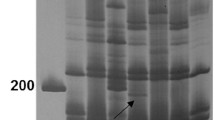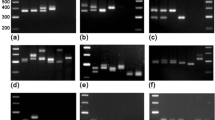Abstract
Tilletia controversa Kühn (TCK) is an important quarantine pathogen that causes wheat dwarf bunt and results in devastating damage to wheat production. The fungus is difficult to be distinguished from T. caries and T. laevis, which cause wheat common bunt, based on morphological, physiological and symptomatological characteristics of the pathogens. The traditional detection of the fungus can be a long and tedious process with poor accuracy. The inter-simple sequence repeat (ISSR) technique has been used for identifying molecular markers for detection of TCK. Of 28 ISSR primers screened, ISSR-859 amplified a specific 678 bp DNA fragment from all TCK isolates but not from any isolates of the common bunt fungi or other pathogenic fungi tested. Based on the fragment sequence, a pair of sequence characterized amplified region (SCAR) primers was designed, which amplified a 372 bp DNA fragment specifically in TCK. The SCAR marker was detected using as low as 1 ng template DNA of TCK, and was also detected using broken teliospores and DNA from asymptomatic wheat samples. We developed the SYBR Green I and TaqMan Green I and TaqMan real-time polymorphism chain reaction methods to detect TCK with the detection limit of 0.1 fg with asymptomatic wheat samples. Further work is needed to develop a rapid test kit for this pathogenic fungus using the designed specific primers.











Similar content being viewed by others
References
Arcade A, Anselin F, Faivre RP, Lesage M, Paques LE, Prat D (2000) Application of AFLP, RAPD and ISSR markers to genetic map** of European and Japanese larch. Theor Appl Genet 100:299–307
Baylis RJ (1958) Studies of Tilletia controversa, the cause of dwarf bunt of wheat. Can J Bot 36:17–32
Davila JA, Lorce Y, Ferrer E (1999) Molecular characterization and genetic map** of random applified microsatellite polymorphism in Barley. Theor Appl Genet 98:265–273
Duran R, Fishcher GW (1961) The genus Tilletia. Washington State University Press, Washington (USA)
Gao L, Chen WQ, Liu TG (2010) Development of a SCAR marker by inter-simple sequence repeat for diagnosis of dwarf bunt of wheat and detection of Tilletia controversa Kühn. Folia Microbiol 55:258–264
Gao L, Chen WQ, Liu TG (2011) An ISSR-based approach for the molecular detection and diagnosis of dwarf bunt of wheat, caused by Tilletia controversa Kühn. J Phytopathol 159:155–158
Gupta M, Chyi YS, Romero-Severson J, Owen JL (1994) Amplification of DNA markers from evolutionarily diverse genomes using single primers of simple-sequence repeats. Theor Appl Genet 89:998–1006
Hess WM, Frione EJ (1986) Use of electron microscopy to characterize teliospores of Tilletia caries and T. controversa. Plant Dis 70:458–460
Hoffmann JA (1982) Bunt of wheat. Plant Dis 66:979–986
Kochanova M, Zouhar M, Prokinova E, Rysanek P (2004) Detection of Tilletia controversa and Tilletia caries. Plant Soil Environ 50(2):75–77
Kojima T, Nagaoka T, Ogihara Y (1998) Genetic linkage map of ISSR and RAPD markers in Einkom wheat in relation to that of RFLP markers. Theor Appl Genet 96:37–45
Lian C, Zhou Z, Hogetsu T (2001) A simple method for develo** microsatellite markers using amplified fragments of inter-simple sequence repeat (ISSR). J Plant Res 114:381–385
Liu JH, Gao L, Liu TG, Chen WQ (2009) Development of a sequence-characterized amplified region marker for diagnosis of dwarf bunt of wheat and detection of Tilletia controversa Kühn. Lett Appl Microbiol 49:235–240
McDonald JG, Wong E, Klassen GR (2000) Differentiation of Tilletia species by rep-PCR genomic fingerprinting. Plant Dis 84:1121–1125
Meekins JF, Ballard HE, McCarthy BC (2001) Genetic variation and molecular biogeography of a northern American invasive plant species (Alliaria petiolata, Brassicaceae). Int J Plant Sci 162:161–169
Meiners JP, Waldher JT (1959) Factors affecting spore germination of twelve species of Tilletia from cereals and grasses. Phytopathology 49:724–728
Menzies JG, Bakkeren G, Matheson F, Procunier JD, Woods S (2003) Use of inter-simple sequence repeats and amplified fragment length polymorphisms to analyze genetic relationships among small grain-infecting species of Ustilago. Phytopathology 23:167–175
Pimentel G (2000) Genetic variation among natural populations of Tilletia controversa and T. bromi. Phytopathology 90:376–383
Pimentel G, Carris LM, Levy L, Meyer RJ (1998) Genetic variability among isolates of Tilletia barclayana, T. indica and allied species. Mycologia 90:1017–1027
Scott KD, Eggler P, Seaton G, Rossetto M, Ablett EM, Lee LS, Henry RJ (2000) Analysis of SSRs derived from grape ESTs. Theor Appl Genet 100:723–726
Sun JH, Li ZC, Jewett DK, Britton KO, Ye WH, Ge XJ (2005) Genetic diversity of Pueraria lobata (Kudzu) and closely related taxa as revealed by inter-simple sequence repeat analysis. Weed Res 45:255–260
Talhinhas P, Neves-Martins J, Leitao J (2003) AFLP, ISSR and RAPD markers reveal high levels of genetic diversity among Lupinus spp. Plant Breed 122:507–510
Trione EJ (1982) Dwarf bunt of wheat and its importance in international wheat trade. Plant Dis 66:1083–1088
United States Department of Agriculture (1998) Risk assessment for the importation of US wheat containing teliospores of Tilletia controversa (TCK) into the Peoples Republic of China. United States Department of Agriculture, Agricultural Research Service and World Agricultural Outlook Board, Washington
Young PA (1935) A new variety of Tilletia tritici in Montana. Phytopathology 25:40–44
Yuan Q, Nian SJ, Yin YP, Li MH, Cai J, Wang ZK (2009) Development of a PCR-based diagnostic tool specific to wheat dwarf bunt, caused by Tilletia controversa. Eur J Plant Pathol 124:585–594
Zietkiewicz E, Rafalski A, Labuda D (1994) Genome fingerprinting by simple sequence repeat (SSR)-anchored polymerase chain reaction amplification. Genome 20:176–183
Zupunski V, Ignjatovic-Micic D, Nikolic A, Stankovic S, Jevtic R, Levic J, Ivanovic D (2011) Identification of Tilletia species using Rep-PCR fingerprinting technique. Genetika 43(1):183–195
Acknowledgments
We appreciate **anming Chen (USDA-ARS and Washington State University, USA) for critical revising the paper before we submitted. We appreciate Blair J. Goates, UADA-ARS, National Small-Grains Germplasm Research Facility for providing T. controversa and T. caries. This work was supported by Bei**g Natural Science Foundation (Grant No. L140012), Multidisciplinary Cooperation Project of Bei**g Nova Program (Grant No. Z141105001814116), Bei**g Nova Program (Grant No. Z131105000413057) and Ministry of Agriculture, P. R. China (Grant No. CARS-03).
Author information
Authors and Affiliations
Corresponding authors
Electronic supplementary material
Below is the link to the electronic supplementary material.
Rights and permissions
About this article
Cite this article
Gao, L., Yu, H., Han, W. et al. Development of a SCAR marker for molecular detection and diagnosis of Tilletia controversa Kühn, the causal fungus of wheat dwarf bunt. World J Microbiol Biotechnol 30, 3185–3195 (2014). https://doi.org/10.1007/s11274-014-1746-5
Received:
Accepted:
Published:
Issue Date:
DOI: https://doi.org/10.1007/s11274-014-1746-5




